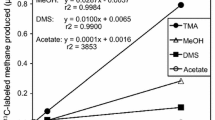Abstract
A possible substrate interrelationship between methane-producing and sulfate-reducing bacteria has been studied in bottom deposits of Lake Vechten. Inhibition of methanogenesis in mud samples by chlorine-containing analogues of methane resulted in accumulation of acetate. Fluoroacetate reduced the concentration of methane by about 75%. With carbon tetrachloride, accumulation of hydrogen gas was observed. These results indicate that acetate is the main precursor of methanogenesis in mud.
After addition of β-fluorolactate, lactate accumulated and H2S was no longer produced, which indicates that lactate is the main source of energy for sulfate reduction in mud. At the same time the concentration of methane increased possibly due to the lower concentration of H2S, which has a toxic effect on methanogenesis. Experiments with intact mud cores provide evidence that the described phenomena occur also in situ.
Similar content being viewed by others
References
Atkinson, L. P. and Richards, F. A. 1967. The occurrence and distribution of methane in the marine environment.—Deep-Sea Res. 14: 673–684.
Bauchop, T. 1967, Inhibition of rumen methanogenesis by methane analogues.—J. Bacteriol. 94: 171–175.
Cappenberg, Th. E. 1972. Ecological observations on heterotrophic, methane oxidizing and sulfate reducing bacteria in a pond.—Hydrobiologia 40: 471–485.
Cappenberg, Th. E. 1974. Interrelations between sulfate-reducing and methane-producing bacteria in bottom deposits of a fresh-water lake. I. Field observations.—Antonie van Leeuwenhoek 40: 285–295.
Davis, J. B. and Yarbrough, H. F. 1966. Anaerobic oxidation of hydrocarbons by Desulfovibrio desulfuricans.—Chem. Geol. 1: 137–144.
Fush, G. W. 1961. Der mikrobielle Abbau von Kohlenwasserstoffen.—Arch. Mikrobiol. 39: 374–422.
Jeris, J. S. and McCarty, P. L. 1965. The biochemistry of methane fermentation using C14 tracers.—J. Water Pollut. Contr. Fed. 37: 178–192.
Khosrovi, B., Macpherson, R. and Miller, J. D. A. 1971. Some observations on growth and hydrogen uptake by Desulfovibrio vulgaris.—Arch. Mikrobiol. 80: 324–337.
McCarty, P. L. 1964. The methane fermentation, p. 314–343. In H. Heukelekian and N. C. Dondero, (eds.), Principles and applications in aquatic microbiology.—John Wiley and Sons, Inc., New York.
Ohle, W. 1958. Die Stoffwechseldynamik der Seen in Abhängigkeit von der Gasausscheidung ihres Schlammes.—Vom Wasser 25: 127–149.
Rufener, W. H. and Wolin, M. J. 1968. Effect of CCl4 on CH4 and volatile acid production in continuous cultures of rumen organisms and in a sheep rumen.—Appl. Microbiol. 16: 1955–1956.
Saleh, A. M., Macpherson, R. and Miller, J. D. A. 1964. The effect of inhibitors on sulphate reducing bacteria: a compilation—J. Appl. Bacteriol. 27: 281–293.
Smith, P. H. and Mah, R. A. 1966. Kinetics of acetate metabolism during sludge digestion.—Appl. Microbiol. 14: 368–371.
Sorokin, Yu. I. 1957. The question of the ability of sulfate-reducing bacteria to utilize methane for the reduction of sulfates to hydrogen sulfide.—Dokl. Akad. Nauk SSSR 115: 816–818.
Stadtman, T. C. 1967. Energy-yielding reactions of anaerobic bacteria, p. 25–39. In V. Fredette, (ed.), The anaerobic bacteria, Proc. Int. Workshop, Laval-des-Rapides, Canada.
Sykes, R. M. and Kirsch, E. J. 1972. Accumulation of methanogenic substrates in CCl4 inhibited anaerobic sewage sludge digester cultures.—Water Res. 6: 41–55.
Thiel, P. G. 1969. The effect of methane analogues on methanogenesis in anaerobic digestion. —Water Res. 3: 215–223.
Wikén, T. O. 1957. Über den Mechanismus des anaeroben bakteriellen Abbaus von Kohlehydrat, Eiweiss und Fett in Faulräumen.—Schweiz. Z. Hydrol. XIX: 428–456.
Wolfe, R. S. 1971. Microbial formation of methane, p. 107–146. In A. H. Rose and J. F. Wilkinson, (eds.), Advan. Microbial Physiol., Vol. 6.—Academic Press.
Wood, J. M., Kennedy, F. S. and Wolfe, R. S. 1968. The reaction of multihalogenated hydrocarbons with free and bound reduced vitamin B12.—Biochemistry 7: 1707–1713.
Zobell, C. E. 1947. Microbial transformation of molecular hydrogen in marine sediments, with particular reference to petroleum.—Bull. Amer. Ass. Petrol. Geol. 31: 1709–1751.
Author information
Authors and Affiliations
Rights and permissions
About this article
Cite this article
Cappenberg, T.E. Interrelations between sulfate-reducing and methane-producing bacteria in bottom deposits of a fresh-water lake. II. Inhibition experiments. Antonie van Leeuwenhoek 40, 297–306 (1974). https://doi.org/10.1007/BF00394388
Received:
Issue Date:
DOI: https://doi.org/10.1007/BF00394388



